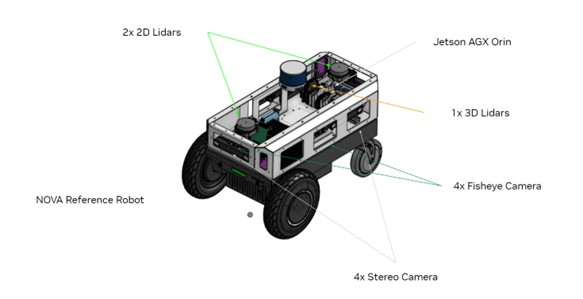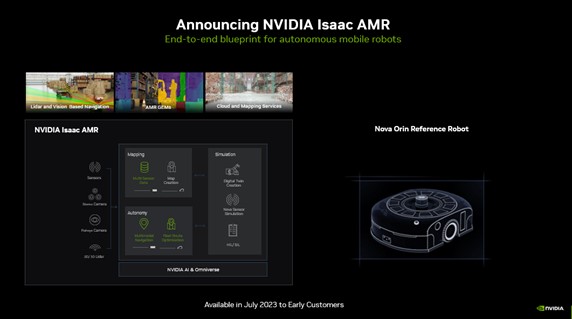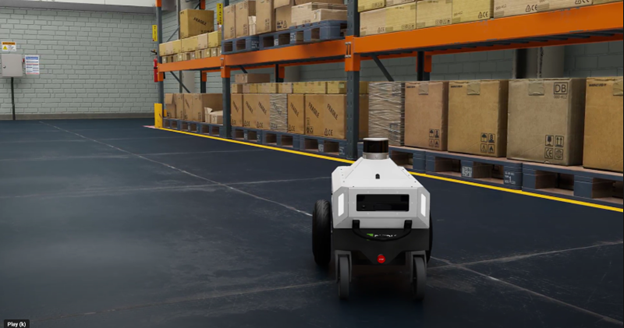Isaac AMR brings advanced mapping, autonomy and simulation to mobile robots and will soon be available for early customers, NVIDIA founder and CEO Jensen Huang announced during his keynote address at the COMPUTEX technology conference in Taipei.
NVIDIA Brings Advanced Autonomy to Mobile Robots With Isaac AMR
Shri Sundaram | NVIDIA
As mobile robot shipments surge to meet the growing demands of industries seeking operational efficiencies, NVIDIA is launching a new platform to enable the next generation of autonomous mobile robot (AMR) fleets.
Isaac AMR brings advanced mapping, autonomy and simulation to mobile robots and will soon be available for early customers, NVIDIA founder and CEO Jensen Huang announced during his keynote address at the COMPUTEX technology conference in Taipei.
Isaac AMR is a platform to simulate, validate, deploy, optimize and manage fleets of autonomous mobile robots. It includes edge-to-cloud software services, computing and a set of reference sensors and robot hardware to accelerate development and deployment of AMRs, reducing costs and time to market.
Mobile robot shipments are expected to climb from 251,000 units in 2023 to 1.6 million by 2028, with revenue forecast to jump from $12.6 billion to $64.5 billion in the period, according to ABI Research.
Simplifying the Path to Autonomy
Despite the explosive adoption of robots, the intralogistics industry faces challenges.
Traditionally, software applications for autonomous navigation are often coded from scratch for each robot, making rolling out autonomy across different robots complex. Also, warehouses, factories and fulfillment centers are enormous, frequently running a million square feet or more, making them hard to map for robots and keep updated. And integrating AMRs into existing workflows, fleet management and warehouse management systems can be complicated.
For those working in advanced robotics and seeking to migrate traditional forklifts or automated guided vehicles to fully autonomous mobile robots, Isaac AMR provides the blueprint to accelerate the migration to full autonomy, reducing costs and speeding deployment of state-of-the-art AMRs.
Orin-Based Reference Architecture
Isaac AMR is built on the foundations of the NVIDIA Nova Orin reference architecture.
Nova Orin is the brains and eyes of Isaac AMR. It integrates multiple sensors including stereo cameras, fisheye cameras, 2D and 3D lidars with the powerful NVIDIA Jetson AGX Orin system-on-module. The reference robot hardware comes with Nova Orin pre-integrated, making it easy for developers to evaluate Isaac AMR in their own environments.
The compute engine of Nova is Orin, which delivers access to some of the most advanced AI and hardware-accelerated algorithms that can be run using 275 tera operations per second (TOPS) of edge computing in real time.
The synchronized and calibrated sensor suite offers sensor diversity and redundancy for real-time 3D perception and mapping. Cloud-native tools for record, upload and replay enable easy debugging, map creation, training and analytics.
Isaac AMR: Mapping, Autonomy, Simulation
Isaac AMR offers a foundation for mapping, autonomy and simulation.
Isaac AMR accelerates mapping and semantic understanding of large environments by tying into DeepMap’s cloud-based service to help accelerate robot mapping of large facilities from weeks to days, offering centimeter-level accuracy without the need for a highly skilled team of technicians. It can generate rich 3D voxel maps, which can be used to create occupancy maps and semantic maps for multiple types of AMRs.
Additionally, Isaac AMR shortens the time to develop and deploy robots in large, highly dynamic and unstructured environments with autonomy that’s enabled by multimodal navigation with cloud-based fleet optimization using NVIDIA cuOpt software.
An accelerated and modular framework enables real-time camera and lidar perception. Planning and control using advanced path planners, behavior planners and use of semantic information make the robot operate autonomously in complex environments. A low-code, no-code interface makes it easy to rapidly develop and customize applications for different scenarios and use cases.
Finally, Isaac AMR simplifies robot operations by tapping into physics-based simulation from Isaac Sim, powered by NVIDIA Omniverse, an open development platform for industrial digitalization. This can bring digital twins to life, so the robot application can be developed, tested and customized for each customer before deploying in the physical world. This significantly reduces the operational cost and complexity of deploying AMRs.
Sign up for early access to Isaac AMR.
The content & opinions in this article are the author’s and do not necessarily represent the views of RoboticsTomorrow
Comments (0)
This post does not have any comments. Be the first to leave a comment below.
Featured Product






